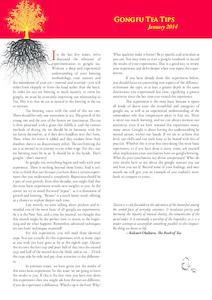
 |
|
In the last few issues, we've discussed the relevance of experimentation in gongfu tea. Without a deep and experiential understanding of your brewing methodology, your teaware and the movements of your art - internal and external - you will either brew sloppily or from the head rather than the heart. In order for our tea brewing to reach mastery, to strive for gongfu, we must be constantly improving our relationship to Tea. This is so that we are as natural to the brewing as the tea or teaware.
Tea brewing starts with the seed of the tea tree. There should be only one movement in tea. The growth of the young tree and the care of the farmer are continuous. The tea is then processed with a grace that fulfills it, and the various methods of drying the tea should be in harmony with the tea leaves themselves, as if they dove headfirst into that form. Then, when the water is added and they awaken from their slumber, there is no discontinuity either. The one brewing the tea is as natural to its journey as any other stage. For that, our tea brewing must be in us. It should be in the hands. That's gongfu - that's mastery!

In gongfu tea, everything begins and ends with your experience. There is nothing beyond those limits. And it isn't wise to think that just because you have done a certain experiment that you understand it completely. Repetition should be a part of your growth. Even after decades, you might find that the most basic experiment reveals new insights to you. At the center, we try to avoid the word "repeat", as it is dismissive of growth and learning. "Renew" is a much better word, offering us a chance to explore deeper each time.
Last month, we were talking about pitchers and reminded you of the most basic of all gongfu tea experiments. As it is the New Year, and a time for renewal, we thought that this month might be the perfect time to return to the beginning and see what happens. Remember, advanced techniques are just basic techniques mastered!
For this experiment, you will need three identical cups. You can actually do this experiment with as many cups as you wish (we have gone as far as the eighth cup). Decant the tea into the first cup and pour half of that into the second cup, and half of the second into the third, and so on... Drink the cups side-by-side and pay close attention to the differences.
In previous issues, we have given you the results of this most basic experiment. In this issue, we are going to leave the results to you. If this is the first time you have ever done this experiment then you might ask how the teas are different, if you do experience a difference. Which cup is the best? Why? January 2014 What qualities make it better? Be as specific and articulate as you can. You may want to start a gongfu notebook to record the results of your experiments. That is a good way to review your experience and delve deeper when you repeat the experiments.
If you have already done this experiment before, you should focus on uncovering new aspects of the differences between the cups, or at least a greater depth in the same distinctions you experienced last time, signifying a greater sensitivity since the last time you visited this experience.
This experiment is the most basic because it opens all kinds of doors unto the mouthfeel and energetics of gongfu tea, as well as an experiential understanding of the tremendous role that temperature plays in fine tea. There is never too much learning, and we can always increase our sensitivity, even if we have renewed this experiment many, many times. Gongfu is about having the understanding be second nature, within our hands. If we are to achieve that level, our skills and our tools have to be honed with lots of practice. Whether this is your first time doing this most basic experiment, or if you have done it many times, ask yourself what implications your conclusions have on gongfu brewing. What do your conclusions say about temperature? What do your results have to say about the gongfu teaware you use and how you use it? Record some of your findings, and next month we will give you an example of one student's notebook to compare to yours...
Teaism is a cult founded on the adoration of the beautiful among the sordid facts of everyday existence. It inculcates purity and harmony, the mystery of mutual charity, the romanticism of the social order. It is essentially a worship of the Imperfect, as it is a tender attempt to accomplish something possible in this impossible thing we know as life.
